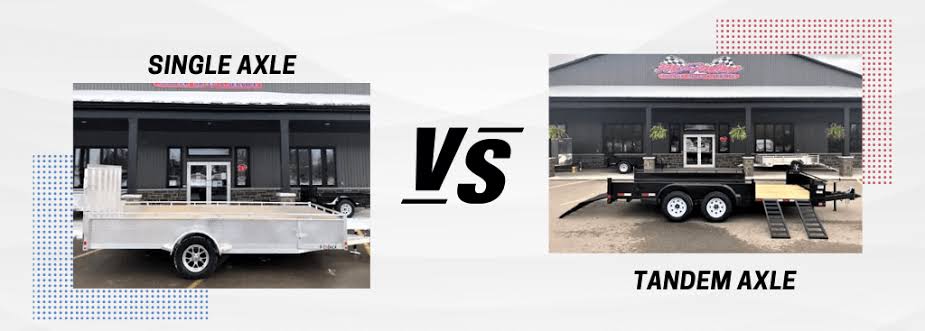When it comes to choosing the right trailer for your hauling needs, one of the most important decisions you will have to make is whether to go with a single axle or a tandem axle trailer. Both options have their own set of advantages and disadvantages, and it ultimately comes down to the specific requirements of your hauling tasks. In this article, we will explore the differences between these two types of trailers, helping you make an informed decision.
Before jumping into the comparison, let’s first understand what a single axle and a tandem axle trailer are. A single axle trailer simply means that there is only one set of wheels supporting the weight of the trailer and the cargo it carries. On the other hand, a tandem axle trailer consists of two sets of wheels, with each set often being closer to the end of the trailer, providing more stability and weight distribution.
Trailer pit – Single or tandem axle? (Which is better)
That being said, let’s dive into the comparison:
- Stability and Weight Distribution:
When it comes to stability and weight distribution, tandem axle trailers have the upper hand. The presence of two axles provides better stability, especially when hauling heavier loads. The weight is distributed evenly across the trailer, reducing the chance of swaying, bouncing, or fishtailing. This makes tandem axle trailers a popular choice for hauling large and heavy equipment, livestock, or any other items that require a higher level of stability during transportation.
Single axle trailers, on the other hand, may be more prone to swaying or bouncing, especially if they are heavily loaded. Due to the lack of an extra axle, the weight is concentrated on a single set of wheels, resulting in less stability during transport. They are better suited for lighter loads or for occasional hauling tasks where stability is not a major concern.
- Maneuverability:
When it comes to maneuverability, single axle trailers take the lead. Due to their lighter weight and smaller size, they are easier to maneuver, making them ideal for smaller spaces or tighter turns. If you frequently need to navigate through narrow driveways or congested streets, a single axle trailer may be a better option. They are also easier to back up, as there is less resistance in turning the trailer.
Tandem axle trailers, on the other hand, are slightly more challenging to maneuver due to their larger size and weight. They require more space to make turns and may be less suitable for navigating through tight spaces. However, many tandem axle trailers are equipped with features such as hydraulic or electric brakes and pivot points, which can help improve their maneuverability to some extent.
- Durability and Maintenance:
In terms of durability, both single axle and tandem axle trailers can be built to withstand rigorous use. However, tandem axle trailers tend to be more durable due to their reinforced construction and the presence of an additional axle. The additional axle helps distribute the weight more evenly, reducing the strain on each individual axle and minimizing the chances of premature wear and tear. This makes tandem axle trailers a popular choice for those who frequently haul heavy loads or travel long distances.
Single axle trailers, although not as durable as their tandem counterpart, can still be long-lasting if properly maintained. Regular inspection and maintenance of the axle, wheels, tires, and suspension components are essential to ensure the longevity of a single axle trailer.
- Cost:
When it comes to cost, single axle trailers generally tend to be more affordable compared to tandem axle trailers. The cost difference primarily comes from the fact that tandem axle trailers require more materials and components, including an additional axle, brakes, and suspension parts. If budget is a concern, a single axle trailer may be a more cost-effective option, especially if you are not hauling heavy loads or do not require the additional stability provided by tandem axles. - Payload Capacity:
Payload capacity refers to the maximum weight a trailer can carry, excluding its own weight. Tandem axle trailers typically have a higher payload capacity compared to single axle trailers. This is due to the additional support provided by the second axle, which allows for a better weight distribution and increased overall capacity. If you need to haul heavy loads on a regular basis, a tandem axle trailer would be the ideal choice. However, if you only need to transport lighter items occasionally, a single axle trailer should suffice.
What to Consider When Converting Single Axle Trailer to Tandem Axle
There are several things to consider when converting a single axle trailer to a tandem axle. These include:
- Load capacity: The load capacity of the trailer is a crucial factor in determining whether it can handle the additional weight of a tandem axle. The combined load capacity of the tandem axle should be greater than the total weight of the trailer and the maximum load it will carry.
- Frame strength: The frame of the trailer must be strong enough to support the additional weight and stresses that will be placed on it. It may be necessary to reinforce the frame or use a heavier gauge steel.
- Suspension: The suspension system of the trailer will need to be modified or upgraded to accommodate the tandem axle. This may involve replacing the current suspension with a heavier duty system or adding additional springs or shocks.
- Wheel spacing: The spacing between the wheels on the tandem axle should be such that the load is evenly distributed and the trailer remains stable. The wheels should be positioned in such a way that they do not interfere with each other or the frame of the trailer.
- Brakes: The braking system of the trailer may need to be upgraded to accommodate the additional weight of the tandem axle. This may involve installing larger brake drums or upgrading to electric or hydraulic brakes.
- Fenders and wheel wells: The fenders and wheel wells may need to be modified or replaced to accommodate the additional wheels of the tandem axle. They should provide enough clearance for the wheels to move freely and prevent interference with the frame or other components of the trailer.
- Wiring and lighting: The wiring and lighting system of the trailer will need to be extended or modified to accommodate the additional axle. This may involve adding additional wiring and lights to ensure visibility and compliance with road safety regulations.
- Legal requirements: Before converting a single axle trailer to a tandem axle, it is important to check the legal requirements in your area. Different jurisdictions may have specific rules and regulations regarding trailer modifications, axle placement, and weight limits.
Overall, converting a single axle trailer to a tandem axle requires careful planning and consideration of various factors. It is recommended to consult with a professional or experienced trailer manufacturer to ensure a safe and proper conversion.
Related posts:
Why does a car shake after changing the ignition coil?
Trailer pit – Single or tandem axle? (Which is better) – Conclusion.
In conclusion, the choice between a single axle and a tandem axle trailer depends on your specific hauling needs. If stability, durability, and the ability to handle heavier loads are crucial factors, a tandem axle trailer is the better option. On the other hand, if maneuverability, cost, and occasional light hauling are your main concerns, a single axle trailer would be a suitable choice. Consider the type of loads you will be hauling, the terrain you will be traveling on, and your budget to make an informed decision.



